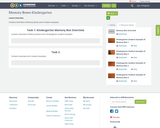
Contains Overview of Memory Boxes and 4 student examples
- Subject:
- Elementary Education
- English Language Arts
- Mathematics
- Material Type:
- Lesson Plan
- Author:
- Katie Shea
- Date Added:
- 06/14/2019

Contains Overview of Memory Boxes and 4 student examples

About the Arts, Care & Connection Lesson Collection: Arts for Learning Northwest collaborated with Oregon teaching artists on this collection of arts integration modules designed for K-5 students, with integrated social emotional learning content in the areas of dance, visual arts, theater, and music.
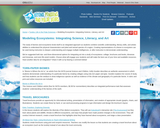
This article describes a number of creative projects that incorporate art and literacy skills into a science unit on biomes and ecosystems.
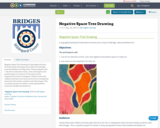
Negative Space Tree Drawing
A Copyrighted Activity Re-Posted with Permission from
Cheryl Trowbridge
www.teachkidsart.net
Objectives:
The participants will:
1. Use the art elements of line, color and negative and positive space to create art
2. Use nature as the inspiration for their art
Audience:
Cheryl works with children and they were the focus for her in creating this lesson but this activity could be used with all ages. This is a perfect project for winter or early spring before trees have budded and leafed out.
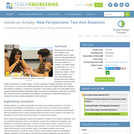
Students learn about two-axis rotations, and specifically how to rotate objects both physically and mentally about two axes. A two-axis rotation is a rotation of an object about a combination of x, y or z-axes, as opposed to a single-axis rotation, which is about a single x, y or z-axis. Students practice drawing two-axis rotations through an exercise using simple cube blocks to create shapes, and then drawing on triangle-dot paper the shapes from various x-, y- and z-axis rotation perspectives. They use the right-hand rule to explore the rotations of objects. A worksheet is provided. This activity is part of a multi-activity series towards improving spatial visualization skills. At activity end, students re-take the 12-question quiz they took in the associated lesson (before conducting four associated activities) to measure how their spatial visualizations skills improved.
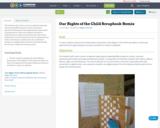
The students will create a woven scrapbook exploring and weaving different genres: poetry, narrative, expository/informative and argumentative/persuasive. In preparation for the book students will need to address literacy, rights and self advocacy. This lesson will pull into current events in the local community and make connections to global scale. As an extension teachers can digitize pieces from the individual books and tie into a longer documentary piece.

Watch as portrait artist, Jeremy Sutton reveals his inspirations, from historical art masters to the passionate subjects of his portraits. Portraits were historically commissioned by either members of the Church or the absurdly wealthy, but Sutton chooses to focus his portraits on the complete opposite -- everyday scenes from everyday members of society, almost as an act of rebellion.

This course provides students with the opportunity to develop a map of contemporary architectural practice and discourse. The seminar examines six themes in terms of their recent history: city and global economy, urban plan and map of operations, program and performance, drawing and scripting, image and surface, and utopia and projection. Students will study buildings and read relevant texts in order to place recent architectural projects in disciplinary and cultural context.
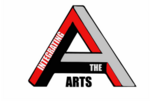
This resource was created by Brittany Wolfgram, in collaboration with Dawn DeTurk, Hannah Blomstedt, and Julie Albrecht, as part of ESU2's Integrating the Arts project. This project is a four year initiative focused on integrating arts into the core curriculum through teacher education, practice, and coaching.
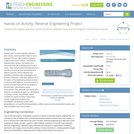
Student pairs reverse engineer objects of their choice, learning what it takes to be an engineer. Groups each make a proposal, create a team work contract, use tools to disassemble a device, and sketch and document their full understanding of how it works. They compile what they learned into a manual and write-up that summarizes the object's purpose, bill of materials and operation procedure with orthographic and isometric sketches. Then they apply some of the steps of the engineering design process to come up with ideas for how the product or device could be improved for the benefit of the end user, manufacturer and/or environment. They describe and sketch their ideas for re-imagined designs (no prototyping or testing is done). To conclude, teams compile full reports and then recap their reverse engineering projects and investigation discoveries in brief class presentations. A PowerPoint(TM) presentation, written report and oral presentation rubrics, and peer evaluation form are provided.
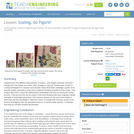
Students learn how different characteristics of shapes—side lengths, perimeter and area—change when the shapes are scaled, either enlarged or reduced. Student pairs conduct a “scaling investigation” to measure and calculate shape dimensions (rectangle, quarter circle, triangle; lengths, perimeters, areas) from a bedroom floorplan provided at three scales. They analyze their data to notice the mathematical relationships that hold true during the scaling process. They see how this can be useful in real-world situations like when engineers design wearable or implantable biosensors. This prepares students for the associated activity in which they use this knowledge to help them reduce or enlarge their drawings as part of the process of designing their own wearables products. Pre/post-activity quizzes, a worksheet and wrap-up concepts handout are provided.
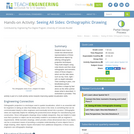
Students learn how to create two-dimensional representations of three-dimensional objects by utilizing orthographic projection techniques. They build shapes using cube blocks and then draw orthographic and isometric views of those shapes—which are the side views, such as top, front, right—with no depth indicated. Then working in pairs, one blindfolded partner describes a shape by feel alone as the other partner draws what is described. A worksheet is provided. This activity is part of a multi-activity series towards improving spatial visualization skills.

This class is a general study of modern architecture as a response to important technological, cultural, environmental, aesthetic, and theoretical challenges after the European Enlightenment. It focuses on the theoretical, historiographic, and design approaches to architectural problems encountered in the age of industrial and post-industrial expansion across the globe, with specific attention to the dominance of European modernism in setting the agenda for the discourse of a global modernity at large. It explores modern architectural history through thematic exposition rather than as a simple chronological succession of ideas.
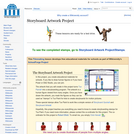
In this project, you create educational materials for schools. If you like to draw human figures or if you have Poser or DAZ Studio, you can join. The artwork that you will create in this project turns Tux Paint into a storyboarding program. The artwork is a human figure viewed from many angles. Once you have drawn the artwork, you mask the figures so they can be used as "stamps" in Tux Paint for kids to create storyboards for motion pictures. These special stamps allow Tux Paint to work like a simple version of Storyboard Quick and Storyboard Artist. Hopefully, this project teaches you everything you need to know to create storyboarding stamps for Tux Paint.

Learn how monotypes are created by examining the work of artist Susan Carney.
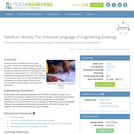
Students practice the ability to produce clear, complete, accurate and detailed design drawings through an engineering design challenge. Using only the specified materials, teams are challenged to draw a design for a wind-powered car. Then, they trade engineering drawings with another group and attempt to construct the model cars in order to determine how successfully the original design intentions were communicated through sketches, dimensions and instructions.
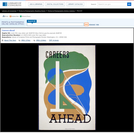
Poster promoting career opportunities in drafting and design, showing drafting tools and abstract design. Date stamped on verso: Sep 7 1939.
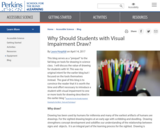
Benefits of drawing for students visual impairements.

Apexer is a street artist who creates colorful, spray-painted murals around the world. Using a visual foundation based in graffiti art and Chinese calligraphy, Apexer abstracts letterforms to create complex, dynamic compositions for his street art projects. Often creating artworks that communicate the vibe of the neighborhood where they are on view, Apexer’s painted gestures are accessible to a wide audience, and are constantly expanding upon the core element of his work: the letters of his nickname.

Student teams act as engineers and learn about systems thinking and scale by reassembling the separated pages of the engaging picture book, “Zoom,” by Istvan Banyai. The book is a series of 31 wordless pictures that start very close-up and then zoom out—from a rooster’s comb to outer space. Like a movie camera, each subsequent page pulls back to reveal the context of the previous scene as something different than what you originally thought. When the 31 un-numbered pages are jumbled, it is a surprising challenge for teams to figure out how the pictures connect. The task prompts students to pause and look closer so as to adjust to new points of view and problem solve to find a logical sequence. It requires them to step back and take a broader view. Students learn that engineers work together as teams and look at things very closely so that they see different things and come up with more than one solution when problem solving. To conclude, students go outside and practice their skills by imagining and then drawing their own Zoom-like small booklet stories inspired by items found in nature. The classic duck/rabbit ambiguous drawing is provided as a kickoff visual aid.